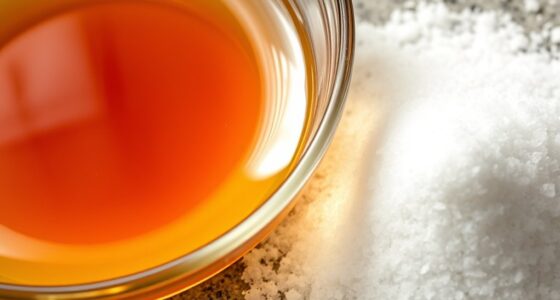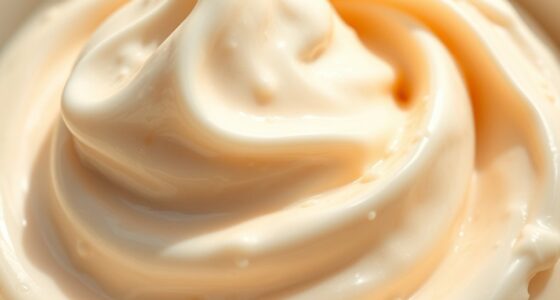When choosing between guar gum and xanthan gum, consider your recipe’s needs. Use guar gum for baked goods like bread and muffins to improve elasticity and structure, especially if you’re vegan. Opt for xanthan gum in recipes requiring a smooth, stable texture, such as sauces or pizza dough, because it suspends ingredients and adds lightness. Each offers unique benefits, so exploring their different roles can help you achieve the perfect result; learn more to make informed choices.
Key Takeaways
- Use guar gum for improving dough elasticity and creating smooth, cohesive batters in gluten-free baking.
- Opt for xanthan gum when needing a stable, light, and less slimy thickener, especially in cold liquids and sauces.
- Choose guar gum for recipes requiring a strong binder and structure, like bread and muffins.
- Use xanthan gum for suspending ingredients, stabilizing emulsions, and achieving a firm yet pliable texture in cookies and pizza dough.
- Experiment with small amounts of each to determine the best gum based on desired texture and recipe type.

Have you ever wondered how guar gum and xanthan gum compare in thickening and stabilizing your recipes? Both are popular choices in the kitchen, especially if you’re into gluten free baking and vegan cooking. These gums act as effective thickeners and stabilizers, helping you achieve better texture and consistency without relying on traditional ingredients like wheat flour or eggs. Understanding their differences can help you decide which to use depending on your recipe and dietary needs.
Guar gum is derived from guar beans and is primarily used as a thickening agent. It’s known for its high water-binding capacity, which makes it ideal for gluten free baking where structure can be tricky to achieve. When you include guar gum in your recipes, you’ll notice improved dough elasticity and crumb stability, especially in bread and muffins. Its ability to create a smooth, cohesive batter makes it a favorite in vegan cooking, where eggs and dairy are often replaced with plant-based alternatives. Guar gum is also easier on your digestive system for many people, making it a good choice if you’re sensitive to other gums. However, it’s important to use it sparingly because too much can lead to a slimy or gummy texture in your baked goods.
Guar gum enhances dough elasticity and crumb stability in gluten free baking.
Xanthan gum, on the other hand, is produced through fermentation of sugars by bacteria. It’s a powerful stabilizer that’s excellent in suspending ingredients, preventing separation, and adding viscosity to liquids. In gluten free baking, xanthan gum mimics gluten’s role by providing the stretch and elasticity your dough needs to hold together. This makes it particularly useful in recipes like pizza dough, cookies, and sauces, where a firm yet pliable texture is essential. Many vegan cooks prefer xanthan gum because it works well in cold liquids and doesn’t require heat to activate. It also tends to produce a less slimy texture compared to guar gum when used correctly. Still, overuse can lead to a sticky or chewy mouthfeel, so precision is key.
Both gums are versatile and can often be used interchangeably, but their unique properties mean that choosing the right one depends on your specific recipe and dietary preferences. If you want a more neutral thickener with a lighter texture, xanthan gum might be your best bet. If you need a more potent binder and want to improve the structure of your baked goods, guar gum could be more suitable. Ultimately, experimenting with small amounts will help you find the perfect balance for your gluten free baking and vegan cooking projects.
Frequently Asked Questions
Can Guar Gum and Xanthan Be Used Together in Recipes?
Yes, you can blend guar gum and xanthan in recipes. Doing so offers benefits like enhanced thickening and improved texture, giving you more recipe flexibility. Combining them allows you to tailor the consistency to your preferences, especially in gluten-free baking or sauces. Just start with small amounts, mix thoroughly, and adjust as needed. This way, you maximize their synergistic properties for better results.
Are There Any Allergies Associated With Guar Gum or Xanthan?
Although rare, some people experience allergy symptoms from guar gum or xanthan. You should be cautious if you have dietary restrictions or sensitivities, especially to gluten or certain bacteria used in fermentation. Always check labels and consult with a healthcare professional if you suspect allergies. Staying informed helps you avoid adverse reactions and guarantees safe use in your recipes, giving you peace of mind with your dietary choices.
How Do Storage Conditions Affect the Shelf Life of These Thickeners?
You should store guar gum and xanthan in a cool, dry place to maintain their storage stability. Moisture sensitivity can cause clumping or spoilage, reducing shelf life. Keep containers tightly sealed to prevent exposure to humidity, which can accelerate deterioration. Proper storage guarantees these thickeners stay effective longer, so always avoid damp environments and check packaging regularly to ensure ideal quality and extended shelf life.
What Are the Environmental Impacts of Producing Guar Gum Versus Xanthan?
Think of producing guar gum and xanthan as tending two different gardens. Guar gum often requires sustainable farming practices and significant water consumption, which can strain local resources. Xanthan production, on the other hand, involves fermentation processes that generally have a lower water footprint but rely on energy-intensive equipment. Your choice impacts environmental sustainability—favoring xanthan may reduce water use, while sustainable guar farming minimizes ecological disruption.
Can These Thickeners Be Used in Gluten-Free Baking?
Yes, guar gum and xanthan gum work well in gluten-free baking because of their thickening properties. You can use them to improve the texture and elasticity of gluten-free dough or batter. Guar gum adds a smooth, creamy consistency, while xanthan provides structure and helps trap air. Both thickeners are versatile, but you might prefer xanthan for bread or dough that needs more stretch and support.
Conclusion
Knowing when to use guar gum or xanthan can really elevate your cooking or baking. For instance, xanthan gum is used in over 50% of gluten-free recipes for its superior thickening power, while guar gum is a natural, plant-based option. By choosing the right one for your needs, you’ll achieve better texture and consistency. So, next time you’re in the kitchen, remember this quick tip—your dishes will thank you!










